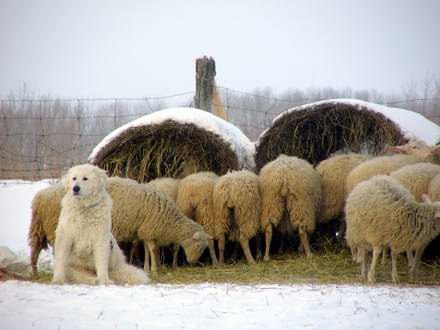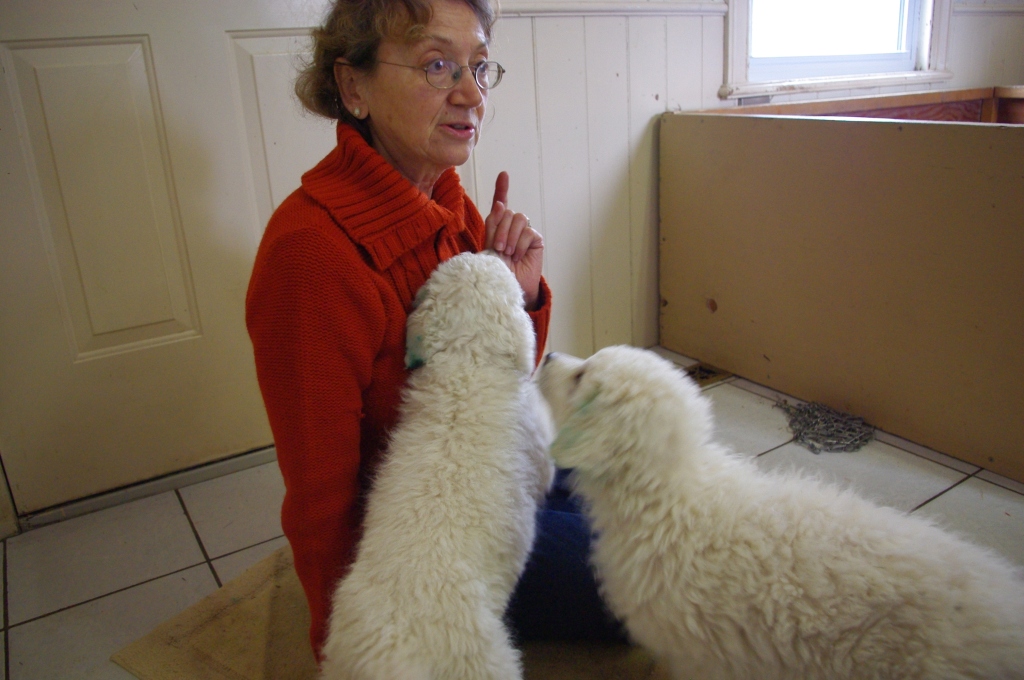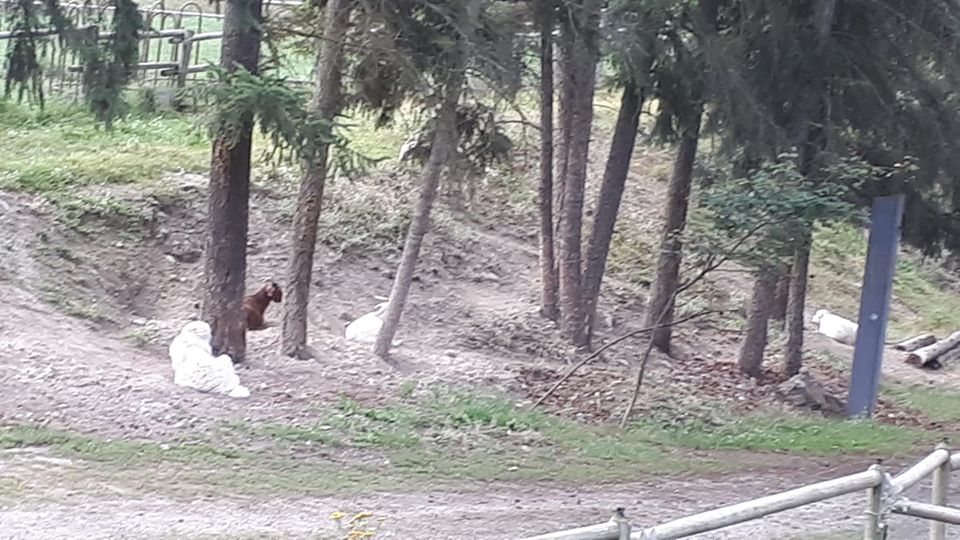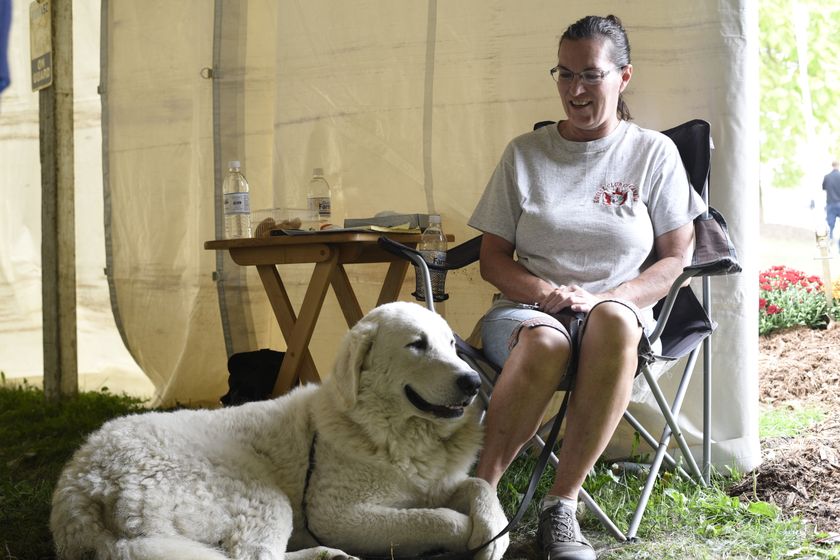During a hike with an entourage on a trail in Ontario’s Algonquin Provincial Park, one of my nephews noted that people passing by always look at K2 lovingly and stop to ask questions about him all the time.

It is true – K2 and other members of his breed are very good-looking dogs. However, make no mistake about it, he comes from a livestock guardian dog breed and in the absence of a flock, he has taken his humans as his charges, and if he sees anyone of us in trouble from a perceived threat, usually street urchins, his seemingly passive protective re-activeness turns into the strike of a rattlesnake.
What is a livestock guardian dog (LGD)?
LGDs protect their charges (cattle, sheep, goats, poultry, etc.) from predators and bandits wherever they move for grazing. They will challenge a dangerous intruder if they perceive it as a threat to their charges, which is livestock in most of the cases.
Most dog breeds in this category are large and muscular – Great Pyrenees from France, Maremmas from Italy, Kangal and Akbash from Turkey, Caucasian and Central Asian shepherds, Komondorok from Hungary, Tatras from Poland, Šarplaninac from Kosova and Serbia, Tornjaks from Bosnia and Croatia, Karakachans from Bulgaria, Bakarwahls from Pakistan, Kuchiani Spae from Afghanistan, etc.

Having studied Kuvasz breed since at least 2008 and gathering information from late Olga Schmidt, Amber Kunz, Kelly Murray, and many other Kuvasz breeders, all dedicated to the breed, I can say that these dogs can prove to be effective for the following three reasons:
Reason # 1 – Protection of livestock:
John Shivik says about LGDs in his book titled ‘The Predator Paradox’: “Sheep see the dog as a herd member, while the dog sees sheep as pack members.”
Kelly Murray of Redmoon Kuvasz Kennels, in her interview later in this article, narrates how her Kuvazsok have protected her livestock effectively and efficiently.
Steve Hounsell, former president of Kuvasz Club of Canada, reports a story of a Kuvasz in Northern Manitoba who engaged a wolf pack, while protecting the flock. The dog was injured in the fight, but did recover. No animals were lost and the wolves moved on to new hunting grounds, possibly frustrated by the encounter.

Reason # 2 – Protection of wildlife:
Using a nice looking dog breed like a Kuvasz would be easily accepted by general public as a deterrent to predators preying upon poultry, livestock, or even endangered wildlife species.
What could be a good solution that is non-lethal to the predators in the region?

Middle Island is a tiny spot of land off Warrnambool, Victoria in southern Australia. This island has recently come into the headlines of a major conservation effort regarding the endangered Fairy penguins living there. At one time 5,000 of these defenseless birds used to live in a colony on the island. However, by 2006, only 10 penguins were all that remained. Culprit? Island predators, as William Stolzenburg mentions in his recent book ‘Rat Island’, foxes and dingoes.
Two pups of Maremma sheepdogs, a beautiful white furred livestock guardian dog breed, were brought in and introduced to the island and the penguins. The Maremmas quickly developed a bond with the penguins and succeeded in keeping foxes and other predators away ensuring that bird population could recover. Today, the penguin population has increased to at least 80 adults and 26 chicks.

Reason # 3 – Protecting people:
When I visited Amber Kunz of Huron Kennels in 2018, along with my wife and K2, it was quite clear that her Kuvaszok were on guard duty and anyone would enter at their own peril. However, thanks to Amber, after they got to know the three of us, when we went back after a month, all of them were more welcoming.

On another occasion, K2’s high pitched barks looking outside on the front street and threatening pacing, brought Police to our home. It was not because someone had complained, but because police acknowledged that he had foiled a burglary next door. The police advised my wife (I was away) “when the dog barks, as a precautionary measure, never go out of the home to check as that could be dangerous. Stay inside, look from windows and if anything looks suspicious call 911”. Apparently our safe and upscale neighbourhood is now slowly and gradually becoming a target of burglars.
If you are living in a neighbourhood that is a target of obnoxious element of the society, a Kuvasz will bring comfort to your household.
The book ‘Following Atticus’ by Tom Ryan is worth reading. It is the remarkable true story of a man and a dog embarking on the challenge of a lifetime. Tom, struggling in his personal life, and his miniature schnauzer companion, the “Little Buddha” Atticus M. Finch, attempted to scale all forty-eight of New Hampshire’s four thousanders (high peaks of the White Mountains) twice in the dead of winter. It is a story of love, loss, and the resilience of the human and animal spirit.

The duo was struck by a tragedy though. Atticus was attacked by two big dogs near a hiking trail and brutally mauled. The little guy recovered though after a long ordeal. On another occasion, the duo ran into a black bear and that could have resulted in a tragedy.
If you are hiking in a city or on lonely trails or trekking in the wilderness, there is a chance that you may encounter similar adversaries. Presence of a well trained Kuvasz, or two, will come in handy. As mentioned earlier, an added advantage of Kuvaszok is that they are gentle if socialized properly and beautiful looking, who will not cause stress to other hikers.

Kuvasz in recent book(s)
Amber’s views on the breed according to an article published in Woodstock Sentinel – Review: “The breed will chase off any predators, from bears to bobcats, or even human intruders trying to break into a home. It’s just instinct, not something the dogs have to learn. They don’t want any harm to come to their family, whether that’s humans or livestock. They bond very strongly.”
In her book titled, ‘Farm Dogs’ (subtitled ‘A Comprehensive Breed Guide to 93 Guardians, Herders, Terriers, and Other Canine Working Partners), Janet Vorwald Dohner writes, “Traditionally used both as LGD and a home guardian, the Kuvasz is a good choice for family farm dog”.

Kuvasz in movies and a TV series
Because of their independent thinking, Kuvaszok, like other LGDs, are not a popular breed for telecasting in the movies. However, in ‘101 problems with Hercules’ (released 1966), a Walt Disney TV series, after his elderly human is injured in a remote area, a Kuvasz, “Hercules,” becomes responsible for herding a flock on his own with only the help of two other dogs (a Border Collie and Old English Sheepdog).
More recently, in the Disney movie “Homeward Bound II’, the lovely Delilah, who has a starring role next to “Shadow” and “Chance,” along with a vast canine cast from Birds and Animals Unlimited, is a Kuvasz.

Kuvasz are also in the movie, “Brady’s Escape” though they only make a brief appearance.
Interview with a Kelly Murray, Kuvasz breeder
My love for Kuvasz breed of dogs has enabled me to make friends with great Kuvasz breeders like Late Olga Schmidt, from whom I got K2 and Amber Kunz of Huron Kuvasz, who is an energetic and a dedicated Kuvasz person attending all farm shows and introducing the breed to people all over Ontario.

Amber Kunz was the first Kuvasz person who I had contacted in Canada in 2010 and have been meeting her at various exhibitions and Kuvasz picnics, and have visited her home in Goderich too. She is always willing to go an extra step to help anyone with respect to their Kuvaszok.
I was, however, able to interview Kelly Murray, who, along with me, started acebook group titled ‘Kuvasz and friends’ and now actively manages those. Our conversation revolved around her farm, experience of using LGDs like Kuvaszok, and her other hobbies to let others know if acquiring an LGD like Kuvasz would make sense keeping in mind their own interests and circumstances.
Here is what she had to say:
On her farm:
We bought a small acreage 12 years ago and started a small hobby farm with goats, laying chickens and raise meat chickens and turkeys at times. We are located in the BC Southern Interior, on the outskirts of a little town called Barriere.

On getting into keeping LGDs
Moon (husband Daryl’s nick name) came home from work one day after 3 or 4 months of living here and told me we needed a Kuvasz. We were in the process of buying Nubian goats and my first question was “what the hell kind of goat is that!?” (Lol) He explained that it was a livestock guardian dog and one of his fellow employees had one. We went in that weekend and met her and fell in love with her. She was a Kuvasz from Amber and Rob Kunz, Huron Kennels. I called Amber and talked at great length about the breed and what they were like and we were on the list for our first Kuvasz, a female puppy to be born November of 2007 and arrive at Kamloops BC airport end of January. With a lot of phone conversations with Amber, we decided to start breeding this beautiful breed which is the only LGD breed we have had.

On other non-lethal measures to protect livestock from predators
We do have electric fences for our farm, but even with them, it did not stop a coyote from killing one of our goats when we had brought our two Kuvaszok into our home after 3 nights of nonstop barking and we could not see what they were barking at. We thought they were barking at the wind. Next morning after Moon left for work, I was doing morning chores and found one dead goat killed by a coyote. Since then, we leave dogs out in the field no matter how much barking they do. We go out to back the dogs up carrying our shotguns and flashlights which sometimes scares off any predators. Sometimes does not but the dogs will carry on barking which keeps them from gaining entry to our farm. I use earplugs when I really want sleep!

About predators in her area
Predators can be coyotes, bobcat, lynx, cougars, wolves (of which we have a large wolf pack of 10 to 14 strong for the last few years), black bears and the odd Grizzly, as well as many human predators that think they can gain entry. They find out quickly they cannot. All our neighbors have thefts but we have not.
On bonding LGDs with livestock
To bond our Kuvaszok with the livestock, we introduce them very young – 4 weeks with our own litters and 12 to 14 weeks with acquired pups from another kennel. We even acquired a 4-year-old male for breeding and all it took was to walk him around the goats for a couple hours and he bonded immediately and became one of our best LGDs. As the pups grow and mature, they usually end up on leads at one point to stop the chase and play or the older dogs do a lot of teaching of the younger for us.
But often times we do have one or two younger ones in with the stock on their own so they will start using their own Independent brains. If they will not stop with the chase and play, we do use training collars. Usually the beep is enough, but if not, they get 3 beeps, if that does not work then they get 3 vibrations before having to use the shock mode. We have trained a lot of puppies and have only had to use that mode twice on a couple of boys who refused to listen. Some people do not agree with this method but when they are in a pasture 300 meters or more away, yelling and running after them does not work and sometimes makes them think “game on!”

On Kuvaszok presenting a threat to humans who are just passing by
Our Kuvaszok do bark at humans that are walking by. They are telling the people “we are here! Stay out!”
On training LGD to be protective of livestock but not aggressive toward humans?
Yes, they can be trained. If people come to our gates to meet the dogs or visit us, our dogs are very friendly once they have been introduced. They will not act aggressively unless people try to gain entry without permission.

On her hobbies
We have many hobbies. Some we do by ourselves or together. For myself, it is sewing and crafts such as knitting, crocheting, needlepoint and painting. Moon does woodworking. I help him sometimes. We both love to hike, bike ride, although have not done a lot in recent years, used to have horses for horseback riding of which we would love to get a couple again sometime but remains to be seen. We snowshoe and cross-country ski also. Love to camp and go fishing.
And our newest hobby is Cowboy Action Shooting with two 357 magnum revolver pistols, a coach style double barreled shotgun and a lever action rifle. This shooting it is done with guns that are replica period 1870s and dressing up in same era. Which is great fun! We also reload our own bullets and shotshells.



Handsome dog breed! I have kangals and pyrs guarding my over 1000 heads of sheep, but I think Kuvaszok will also make very good livestock protections dogs. And yes they are very nice looking dogs.
LikeLike
Hi Anita,
Thanks for the lovely comments.
Best regards,
LikeLike
what a beautiful dog breed! is k2 your dog that appearing on your story on Hautes-gorges national park?
LikeLike
Thank you, Chloe!
No, that dog, a great Pyrenees 7 months old puppy, belonged to a family from Quebec itself who were hiking slightly behind us.
LikeLike